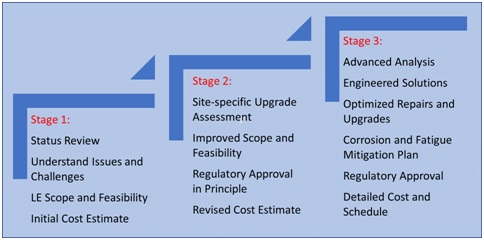
Life Extension for Offshore Floating Assets, Part 2 Developing a Life Extension Plan
The benefits and challenges of safely and effectively extending the operating life of an asset is well described in Part 1 of this discussion on life extension (LE). In this second part, logical and step-wise approach to developing LE plan that meets the interests of all stake holders is explained.
The stepwise approach to LE presented here, creates a series of management decision gates. The premise is that extending the service life of a facility is a business case that is under consideration. As with everything, it is not a foregone conclusion that extending the service life is feasible for the given asset. The LE process progressively informs the stakeholders of the indicative costs and risks of implementing the plan. Each step provides a greater level of detail as inputs to the decision-making process, which determines the viability of increasing the service life. A key aspect of the study is to define the effort required to drive risk to as low as reasonably practicable.
DEVELOPING A LIFE EXTENSION PLAN
What is described here are the actions typically needed to assess the key aspects of the asset, predict future performance, determine any immediate remediation or enhancements needed, and develop a plan to inspect, monitor, and maintain the facility in future years. The three-stage plan set out below allows for progressive assessments to be made by the duty holder and investors as to the viability of extending the asset’s life.
STAGE 1: DATA GATHERING AND INITIAL FEASIBILITY ASSESSMENT
At the outset it is essential for the operator to gather all available data to develop an understanding of the performance history and status of the asset. Usually the data gathering is achieved through a combination of data file and archive searches plus workshops involving all those with knowledge and understanding of the facility. This activity must address all the aspects that will need to be considered by the duty holder and, where applicable, the verification body/class society, and the government regulators. Potential impacts of updated codes and standards and new/revised regulations need to be considered to gain a reasonable understanding of the impact of these.
The output of this study should be a LE feasibility assessment that sets out the scope of work needed to fully develop the plan. It should identify the potential pain-points where the risks, uncertainties, and/or costs may become highly critical. It is not expected for these to become show-stoppers, but rather to focus attention and effort.
The objective of this first stage is to provide the stake holders with an initial assessment of the feasibility of LE. This limited effort work simply paints the big picture.
STAGE 2: ASSESSMENT, REVISED ESTIMATES AND REGULATORY INVOLVEMENT
In this stage, the operator should perform detailed work to acquire a reasonable level of understanding of the cost, effort, and schedule needed. If necessary, they should authorize some engineering work to determine, for example, the extent of structural repairs needed or other major physical work that probably would be, by its very nature, high cost.
This is normally the stage where the regulatory body(ies) would be engaged. This is to get their approval in principle to the LE plan and to understand their needs and concerns, so that these are addressed in the detailed plan development.
Similar to stage 1, the objective is to provide the stake holders with an updated assessment of the feasibility of LE.
STAGE 3: DEVELOPING THE DETAILED LIFE EXTENSION PLAN
The outcome of this stage is the detailed work scope, cost, effort, and schedule to allow the asset to continue operating. For well maintained assets this may only be desk top work to update the inspection, monitoring and maintenance plans, and other similar work.
Where there has been some deterioration of the structure, rehabilitation work will be needed. Where the asset is to remain on station, the simple shipyard approach of cutting out and renewing steel is likely to be impractical or, bluntly, impossible. In these cases, engineered solutions are needed to add steel with little or no removal of original material. The basic truth is that advanced engineering to reduce the tonnage of steel renewal is a cheap option.
Changes to codes and standards or the introduction of new or updated regulations need to fully be addressed. In some instances, additions or modifications may be necessary to comply with these changes. In other cases, the impacts of changes need to be understood and assessed from a risk perspective. The recently updated API met-ocean guidance is a good example of this. A 20-year-old structure, say, is almost certainly not going to meet the requirements of current met-ocean standards. The LE plan needs to recognize the shortfall and, from this, determine the risks and mitigations needed to manage the situation.
Submission of required documents to the verification body, class society, and regulator(s) to gain approval to the LE plan would be done at this stage.
The completion of this stage should allow a robust and detailed cost estimate and schedule to be developed and presented to the decision makers.
CONTINUED SERVICE OR LIFE EXTENSION?
There is a belief that the extensive LE studies commonly completed to justify operating beyond the original design life are not required. This would be very reasonable if all the key aspects of performance were fully understood and documented but, in many instances, this is not the case. Historical data such as inspection and maintenance records, load data to support fatigue assessments and the like are, at best, fragmented and, in many cases, simply not available. The reasons for this are many and varied, and not the subject of this paper. The simple fact is that the less complete the knowledge and data is, the more effort is required to justify continuing to operate beyond the original design life.
Let’s Talk
We will help you overcome strategic challenges to realize the business value you seek.

Brian Gibbs
Senior Consultant
Brian and is a highly experienced Integrity Management (IM) and Risk Specialist. His achievements span the entire asset life cycle including concept/ feasibility design studies; risk assessments; incident investigations, capital project verification; in-service inspection and integrity…
